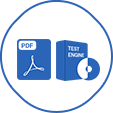Last Update 20 hours ago Total Questions : 62
The Emergency Medical Technicians Exam content is now fully updated, with all current exam questions added 20 hours ago. Deciding to include EMT practice exam questions in your study plan goes far beyond basic test preparation.
You'll find that our EMT exam questions frequently feature detailed scenarios and practical problem-solving exercises that directly mirror industry challenges. Engaging with these EMT sample sets allows you to effectively manage your time and pace yourself, giving you the ability to finish any Emergency Medical Technicians Exam practice test comfortably within the allotted time.
A patient has heart failure with pulmonary edema. They have shortness of breath, and crackles are present in both lungs. The patient is nauseated and has vomited once. The vital signs are BP 90/40, P 110, R 10, and SpO₂ 89% on room air. Which of the following signs or symptoms prevent the EMT from using CPAP? Select the three correct options.
Following an EMS call, any requests concerning protected health information should be directed to the
What characteristics of the pediatric airway are different from the adult airway?
A 27-year-old patient reports trouble breathing after being struck by a car. Which of the following findings are indicative of a possible chest wall injury? Select the three answer options that are correct.
A drowsy 72-year-old female complains of difficulty breathing. Her respiratory rate is 50, and her SpO₂ is 89% on room air. You should suspect
A 26-year-old patient has an altered mental status. Family advises that the patient has diabetes. The patient's skin is pale, cool, and clammy. What, if anything, can the EMT infer about the patient's glucose level based on the patient's presentation?
An 84-year-old patient has a sudden onset of weakness to one side of the body. The patient has a history of hypertension and high cholesterol. The vital signs are BP 176/94 mmHg, P 108/min, R 18/min, and SpO₂ 97% on room air. For which of the following additional symptoms should the EMT assess? Select the three correct options.

